How to develop and use Strategy Maps to:
- Explain your strategy better,
- Improve understanding and ownership of your strategy,
- Encourage people to be more strategic,
- Reliably deliver your strategy.
Whether you are an Executive, Manager or Practitioner, you are in the right place… If you want to modernise or upgrade your balanced scorecard, so it makes a difference to your strategy, then strategy maps are the place to start. This page provides an essential introduction to Strategy maps, their benefits and how they work.
What you will learn here…
“I can carry the strategy around in my pocket. If I want to discuss the strategy with another manager I simply say,’Hey, let’s have a look at your strategy map’.” Graeme Law, Strategic Planning Advisor, Peterborough City Council
This page describes the benefits that well designed strategy maps can bring. It explains what strategy maps are and how they dramatically re-focus and move a balanced scorecard from operational detail to strategic intent. It describes some of the problems they solve and shows how strategy maps improve the design and effectiveness of balanced scorecards when managing both strategy and performance. It touches on public sector and NFP applications, as well as commercial uses. You will also learn how to avoid some of the most common mistakes people make when designing and implementing strategy maps.
Quick links to Strategy Map topics on this page:
- Strategy Mapping book: A complete guide to strategy mapping (recommended by David Norton). Strategy Mapping book
- The benefits of strategy mapping Strategy Mapping Benefits
- The problems strategy maps solve in balanced scorecard design and use. The problems they solve
- Strategy Mapping 101: A 20-minute instructional video explaining how strategy maps replaced the simplistic 4 box model and why they work. Strategy Mapping 101 video
- How build and design strategy maps capture your strategy. Capturing strategy
- Managing using your strategy map. Managing using strategy maps
- Strategy maps in the public sector and NFP organisations. Public sector & NFP Strategy Maps
- Case studies with Strategy maps helping organisations. Case studies of strategy map implementations
- Six important things to remember with Strategy Maps. Important design criteria
- Get help, experience and expertise. Get help with your strategy map project
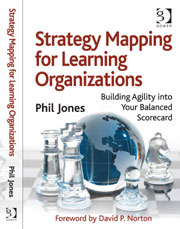
1) A complete guide to designing, implementing and using Strategy Maps to support strategy execution:
Before we dive into detail, this page contains some of the basic messages from my book, Strategy Mapping for Learning Organizations, Author, Phil Jones (Published by Gower, December 2011). The foreword of the book was written by David P Norton himself. In that foreword David Norton says:
“This book is a ‘drivers manual’ for anyone who is implementing a Balanced Scorecard performance management system […] it is required reading.” Dr David P Norton, Joint Author of The Balanced Scorecard
Want to know more? To learn more about the Strategy Mapping book, read David Norton’s foreword in full, to or to find out how to buy “Strategy Mapping…”, simply click on the cover or this link.
2) What are the benefits of using Strategy Maps?
Strategy maps capture and communicate your strategy
Strategy maps help you to ensure your strategy will be more successful, because they help you to capture, communicate and manage your strategy better. Strategy maps capture your management team’s thinking in a rich manner, so it is easy to communicate. Strategy maps explain how the strategy will bring about change. They help you avoid “Strategy by Hope and Magic”.
If your staff don’t get the strategy, that could make a big difference. When a client used the phrase, ‘A piece of the strategy in everybody’s pocket’ I knew exactly what he meant. Because Strategy maps are a rich and succinct picture of an organization’s strategy they are a powerful tool of communication. I know many clients who have carried their strategy maps around to explain their strategy. Others have kept a large version on their wall, or the office wall, so that the whole organization can see what needs to be achieved, and can track progress. People can easily see where they fit in and contribute. This is an example of a Chief Executive who had her strategy on a page with her Strategy Map
Strategy maps help you manage performance better.
They help you to manage the strategy and focus on change, while the scorecard contains the operational detail that supports this. Strategy maps raise the level and quality of conversation amongst a management team. They can be used to discourage silo thinking and encourage joined up thinking and working.
If you want a more responsive adaptable organisation that recognises that the strategy will evolve as you implement it, then Strategy maps, used as a part of an overall Strategic Learning process will help you. Because Strategy Maps are such a succinct tool for capturing strategy on a single page, they are also more easily adapted and refined than traditional thick plans. They help you to become an organisation that learns as it executes its strategy .
Strategy maps capture important elements of strategy: focus, choice and drivers of change.
Strategy maps are created by asking questions about the strategy. What are the few things that will make the biggest difference? What will drive change? What capabilities do we need to learn and grow to improve processes and bring about improvements for customers and finances?
The power of strategy maps lie in the links between the objectives and how they tell the logic and story of your strategy.
Strategy maps help you create a strategic balanced scorecard.
If your balanced scorecard does not use a Strategy Map, then you do not have a proper Norton & Kaplan Balanced Scorecard. Without one, you have what Bob Kaplan describes as “An operational scorecard”. Without a strategy map, your scorecard will remain an operational tool, rather than one of strategy communication and execution.
Strategy Maps are fundamental to the Norton & Kaplan approach; an approach to managing strategy and its execution successfully. Their use and role in balanced scorecard design is clearly set out in the second chapter of Norton & Kaplan’s first book, “The Balanced Scorecard” (see pages 29-31), though they only became known later as Strategy maps. It is odd that so many try to implement scorecards without the insights and focus that a strategy map provides.
Strategy maps raise the discussion from operations, to strategy
Strategy Maps are fundamental to the Balanced Scorecard as a tool of Strategic Management. They make the difference between an operational view and a strategic perspective. They raise the level of conversation from operational detail to strategy and change.
Strategy maps help you to systematically design measures and align investments
Strategy maps sit above the scorecard to provide a structured description of the strategy and what drives performance. Strategy maps contain objectives, which are developed before measures are chosen. Using the objectives in a strategy map means that you will choose the most appropriate measures and targets in your scorecard. The objectives in strategy maps also help you align projects. By introducing strategy maps we have identified significant savings from the overall programme and projects portfolio. Do you want to systematically align your organisation?
Strategy maps also help you align investments and projects or programmes of change.
“Our Balanced Scorecard roll out has been fantastic in helping with conversations and dialogue. It has forced our managers to think more strategically and talk to their teams about what is important.” Chris Ingram, Operations Director, Adepta.
Strategy maps: a stepping stone to the benefits of Fourth Generation Strategic Balanced Scorecards
If you are using strategy maps you are starting to do third generation balanced scorecard thinking; a form of thinking that enables you to systematically manage your strategy and its execution.
You also have an essential pre-requisite to go a step further. If you want to be an agile learning organisation that treats strategy as a learning process, then strategy maps can help you, as a part of Excitant’s Fourth Generation Balanced Scorecard approach.
3) What problem with Balanced Scorecards do Strategy Maps solve?
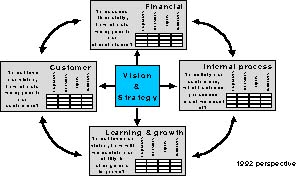
Avoid the outdated cruciform model for balanced scorecard design
Many of you will be familiar with this diagram that represents the earliest balanced scorecard model in “The Balanced Scorecard”. It was discarded quite quickly by Norton & Kaplan (You never see it in any of their other four books) but, unfortunately, it is all over the internet. It is an early balanced scorecard framework which dates back to 1992 when balanced scorecard perspectives were first developed. It is described on page nine of Norton & Kaplan’s first book as a framework that shows how the perspectives support the strategy and vision.
Balanced scorecards have always been about cause and effect and strategy maps
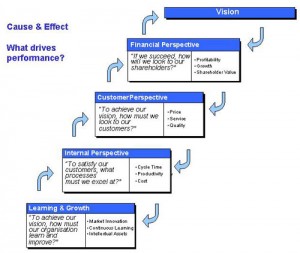
However, read page 30 of the very same book “The Balanced Scorecard” and it explains that this diagram is merely a framework to show how they relate to strategy. What really matters is the cause and effect between perspectives: the relationship that forms the strategy map. This old cruciform framework was discarded as a model of balanced scorecards by Norton and Kaplan as early as 1995. The strategy map cause and effect framework, with the perspectives stacked on top of each other, and clear relations between them, is the one you need. That model is the one strategy maps use.
Solving these problems by discarding the old model
Why was it discarded? It merely describes how the perspectives link to strategy: it serves no other purpose. It certainly is not the overall model. The arrows have no meaning, it has no cause and effect model that drives performance. It encourages collecting measures in perspectives, it is difficult to cascade and leads to measure mania where lots of measures are collected and categorised without any real structure or purpose. It leads to operational balanced scorecards that contain potentially hundreds of measures. Ultimately this approach creates a culture of measurement rather than performance.
The strategy map model which replaced this solves all of these problems. Using the strategy map framework, instead of this cruciform model, will dramatically improve the effect of your balanced scorecard and make it much more useful as a tool of strategy, communication and change.
Our view is that Norton & Kaplan’s book Strategy Maps, (which was published in 2004) was a plea for people to understand the importance of Strategy Maps in the whole Balanced Scorecard approach: a role that many had missed from the earlier books, “The Balanced Scorecard” and “The Strategy focused Organization”.
Isn’t it about time you updated your balanced scorecard?
4) Strategy mapping 101 video
This short video explains how strategy maps work, how they differ from the simplistic 4-box balanced scorecard model and how they are developed and used to explain the story of the strategy. Strategy mapping 101 Video
We provide training in modern balanced scorecards and strategy mapping.
5) How do strategy maps capture your strategy?
“Even five years on, we are still using the strategy map and balanced scorecard you helped us develop. It has been central to building our capability as a department and focusing on delivery to our clients.” Mike Martin, Managing Director, Anglian Water Technical Services
A Strategy Map is a pictorial representation of your strategy. A Strategy Map contains the answer to the question, “What do you want to accomplish, and what will drive that change?”
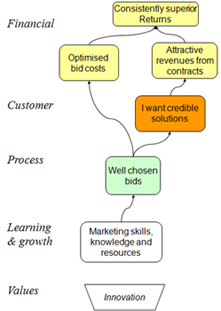
A Strategy Map contains objectives that are linked in a cause and effect relationship. The cause and effect relationship is described between objectives in perspectives. Those perspectives are the four main perspectives of the Balanced Scorecard approach, which describe the cause and effect relationship. The scorecard components (Objectives, measures, targets, initiatives, assessments, responsibility) sit behind the objectives on the strategy map.
Strategy maps contain themes: Here is a simple example.The second picture on the right shows the generic perspectives that we start with that hold the cause and effect model.
A Strategy Map describes your strategy and tells your story of your strategy. It shows, visually, how you expect to create value in the organisation and for your customers. It describes what you believe will drive change. (The example on the right shows the structure of a part of a strategy map for the bid process of a commercial organisation. It shows their objectives in each of the perspectives.
A Strategy Map does not contain measures, it contains objectives. You can place your measures on the strategy map, alongside the objectives they correspond with.

Describing the strategy as a cause and effect model of objectives in different perspectives, and then selecting measures, simplifies the selection of measures in the Balanced Scorecard. Strategy maps instil the discipline of “Objectives before Measures”.

Strategy maps are part of the overall Balanced Scorecard Management Approach. A Strategy Map sits in front of its scorecard (the Balanced Scorecard). Each scorecard has a strategy map. Rather, each strategy map has a scorecard behind it.
A Strategy Map for a management team, unique to that organisation
A Strategy Map is developed from the perspective of a single management team. Each management team will have their own strategy map which describes their part of the strategy. So each management team’s Strategy Map tells the story of the strategy from the perspective of that management team. If you create one for the organisation’s Executive team, it will represent the overall organisation’s strategy, from their perspective. However it is not the strategy map of any of the teams underneath them.
Each management team has their own Strategy Map, so overall this creates a cascade of strategy maps as the strategy is cascaded through the organisation; an individual strategy map representing that management team’s contribution to the overall strategy.
Strategy Maps are unique to that organisation. They represents that organisation’s strategy. No one else’s strategy. For this reason strategy maps should not be copied, unless you intend to also copy that organisation’s strategy (I strongly advise you avoid copycat strategy).
Strategy maps are about focus, choice and change
A Strategy Map is about focus and choice. A Strategy Map for a management team contains the few things that the team have to focus on to make the biggest difference. For this reason, Strategy Maps are not operational maps: They do not contain everything. They contain the few objectives that are most important and that describe the cause and effect relationship. This means you have to ask the right questions about what drives performance, in the right order when developing a Strategy Map.
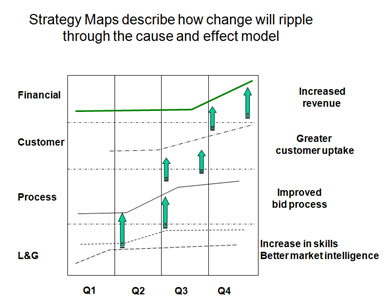
A Strategy Map is about change. If the objectives in the lower perspectives are achieved this should ripple through to improvements in the objectives in the higher perspectives. (See diagram). This is the cause and effect relationship working.
A Strategy Map is often be divided into strategic themes. These are vertical slices across the perspectives, each one describing as aspect of how the strategy creates value. A Strategy Map usually contains multiple strategic themes.
In the Fourth Generation Strategic Balanced Scorecard we build on an organisation’s business model and then build the strategy map. We only add additional perspectives, where they support the business model and yet preserve the core cause and effect relationship. This includes the organisation’s values, the demands of regulators, the need for objectives representing social and environmental impact and the need to monitor the external environment.
6) Managing using Strategy Maps alongside Balanced Scorecards
“Our Balanced Scorecard is probably the best initiative that we have achieved. It provides a way of talking about the business, how and why it is developing. It is a tool for analysis and discussions. It helps us to track progress and tell where we are up to” Steve Inch, Deputy Chief Executive, Dimensions
A Strategy Map is used to review progress against the strategy. It supports the Strategic Management process. The scorecard part of the Balanced Scorecard approach is used to review operational progress: the Operational Management process. The two work together.
A Strategy Map review should ask questions about the strategy. Is our strategy working? Do we need to change it or refine it? Strategy Maps are not static tools. They are tools of management that get refined and developed as management learn from their strategy and the strategy evolves.
When management teams use Strategy Maps in their meetings the conversation rises to a highest level, there is less operational detail and more time spent reviewing whether the strategy is working or not, and why.
This also raises the heads of people in the organisation, who are also then able to discuss, understand and contribute to the strategy, so that it is more likely to be delivered.
This combination of thinking strategically and operationally is a fundamental part of our Fourth Generation Strategic Balanced Scorecard approach.
7) Strategy maps in the public sector and not-for profit organisations
“The Board has the detail and confidence they were looking for. Our Balanced Scorecard makes it far easier to prepare for Board meetings: I simply review our Balanced Scorecards and I feel I am fully briefed.” Dr. Astrid Bonfield, Chief Executive, Diana, Princess of Wales, Memorial Fund
Some people think that Strategy Maps and the Balanced Scorecard do not work in public sector and third sector organisations. They are wrong! We are reminded of the phrase, “Those who say it cannot be done, should not get in the way of those who are doing it”. We have helped organisations as diverse as Local Authorities, NHS trusts, Charities, Fund providers, Central Government, the MoD, Hospices and Social Care organisations develop their strategy maps. In every case we were capturing and implementing their strategy, as a not for profit organisation, using Strategy Maps and strategic balanced scorecards.
Several of our public and third sector clients have commented how the approach helps them to manage change in a way that they have not been able to before. Why? because at last they were seeing their business or operating model more clearly. As a result they could see where they wanted to apply change and how to apply those changes. This came from designing strategy maps that suited that particular Not for profit organisation.
A Strategy Map in a public sector, or not-for-profit organisation provides many of the the same benefits as a strategy map for a commercial organisation. Its basic structure is similar, with one exception. The exception is that the outcome perspectives are arranged differently to reflect the challenge satisfying their community, economically, whilst serving regulators or politicians. We call this “The three ball juggle”.
“The amount of change you have helped us create in the organisation in only 5 months has been terrific. There has been an ingrained culture, a way of working. It is pretty impressive to be changing that in a 5 month project.” Trevor Gibson, Director of Environmental Services, Peterborough City Council
One particular advantage of using Strategy Maps with public sector Balanced Scorecards is that they are much better than traditional and simplistic public sector scorecards at capturing and explaining the more complex service delivery models and strategies that the public sector needs today. For instance, we have used them to describe strategy across the whole of a strategic health authority, across all the care services within a Primary Care Trust, across all the services provided by a Unitary council. Designed with the service delivery model in mind, they are a powerful tool for describing what a strategy should change and also monitoring the benefits as they are implemented.
They enable you to articulate, far easier, how cost savings, policy change, and preventative measures affect operations and ultimately the population and finances. You can also show how preventative strategies applied at one part of the landscape, perhaps changes to policing or health improvements, can ripple through to benefits further along the chain to benefit, say, the courts or acute hospitals.
We have a wide experience of public sector, third sector and charity balanced scorecards, so contact us for more details.
8) Six things to remember about strategy maps
- Always design your Strategy Map before you think about your scorecard. Do not worry about measures: concentrate on objectives in the Strategy Map. Measures and the rest come later.
- The creation of the Strategy Map is a process of conversation and exploration within a management team. Never try to short-cut this conversation process. It is how ownership is developed.
- Never use someone else’s Strategy Map unless you are also using their strategy as well. Especially do not copy a Strategy Map from a book. Strategy Maps need to be created by the management team that will use them, so you have their ownership. They should reflect their thinking, not someone else’s.
- Never add additional perspectives if they destroy the cause and effect relationship. They are not categories of measures, but part of a cause and effect relationship. Instead use a vertical “strategic theme” that crosses the existing perspectives.
- Strategy Maps are not operational maps. If you find yourself mapping the existing processes in detail you have probably gone down a rabbit hole. Strategy is about focus and choice. Concentrate on the few things that will make the biggest difference.
- As a minimum, you should be able to read into your Strategy Map, your business model, the customer’s business model, how you will deliver value to your customer, and how you intend to change. If you can’t, then you haven’t captured your strategy. If you have not captured your strategy then you won’t communicate your strategy and the Strategy Map will not help you to deliver your strategy.
Futher reading
- Find out about The Fourth Generation Strategic Balanced Scorecard Approach
- Learn more about Strategy in “The Strategy Zone“
- Learn more about Modern Balanced Scorecards in “The Modern Balanced Scorecard Zone“
- Learn more about how performance is managed in “The Performance Management Zone“
- Learn more about Socialising strategyin “The Executive’s guide to communicating and socialising strategy“

